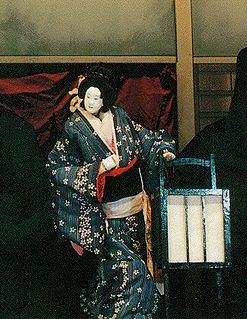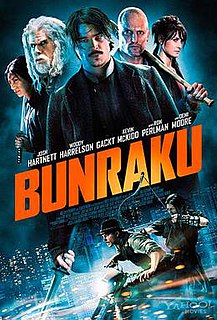 W
WBunraku , also known as Ningyō jōruri (人形浄瑠璃), is a form of traditional Japanese puppet theatre, founded in Osaka in the beginning of the 17th century. Three kinds of performers take part in a bunraku performance: the Ningyōtsukai or Ningyōzukai (puppeteers), the tayū (chanters), and shamisen musicians. Occasionally other instruments such as taiko drums will be used.
 W
WBunraku is a 2010 martial-arts action film written and directed by Guy Moshe based on a story by Boaz Davidson. The film stars Josh Hartnett, Demi Moore, Woody Harrelson, Ron Perlman, Kevin McKidd, and Gackt and follows a young drifter in his quest for revenge.
 W
WBunraku Bay Puppet Troupe is an American puppet troupe that performs the traditional Japanese puppet drama commonly known as ningyō jōruri or Bunraku. Based in Columbia, Missouri, the Troupe is directed by J. Martin Holman, retired professor of Japanese language, literature, and theater at the University of Missouri, and the first non-Japanese to train and perform in the traditional puppet theater in Japan. The original puppeteers of Bunraku Bay Puppet Theater were trained in Japan by members of three traditional puppet troupes: the Tonda Puppet Troupe, founded in the 1830s in Shiga Prefecture, Japan; and the 300-year-old Kuroda Puppet Troupe and the Imada Puppet Troupe of Iida, Nagano Prefecture, Japan. In recent years most members of Bunraku Bay have spent summers training with the Imada Puppet Troupe.
 W
WChikamatsu Monzaemon was a Japanese dramatist of jōruri, the form of puppet theater that later came to be known as bunraku, and the live-actor drama, kabuki. The Encyclopædia Britannica has written that he is "widely regarded as the greatest Japanese dramatist". His most famous plays deal with double-suicides of honor bound lovers. Of his puppet plays, around 70 are jidaimono (時代物) and 24 are sewamono (世話物). The domestic plays are today considered the core of his artistic achievement, particularly works such as The Courier for Hell (1711) and The Love Suicides at Amijima (1721). His histories are viewed less positively, though The Battles of Coxinga (1715) remains praised.
 W
WThe Kuroda Puppet Troupe (黒田人形座) is a traditional Japanese puppet troupe in the style commonly known as ningyō jōruri or bunraku based in the city of Iida in Nagano Prefecture. Founded in 1688, the Troupe has performed continuously to the present.
 W
WKuroko are stagehands in traditional Japanese theatre, who dress all in black.
 W
WThe Master Puppeteer (1975) is a historical novel for children by Katherine Paterson. It won the 1977 U.S. National Book Award in category Children’s Literature.
 W
WNamiki Sōsuke, also known as Namiki Senryū, was a prominent Japanese playwright who wrote for both kabuki and bunraku. He produced around 47 bunraku plays, nearly 40 of them composed for jōruri, a particular form of musical narrative, and 10 kabuki plays. He is considered the second greatest Japanese playwright after Chikamatsu Monzaemon.
 W
WThe National Bunraku Theatre is a complex consisting of two halls and an exhibition room, located in Chūō-ku, Osaka, Japan. The complex was opened in 1984 as the fourth national theatre of the country, to become the headquarters of bunraku.
 W
WTonda Puppet Troupe , founded in the 1830s, is one of the most active groups performing traditional ningyō jōruri or Bunraku puppetry in Japan, and has been officially designated an Intangible Cultural Treasure.